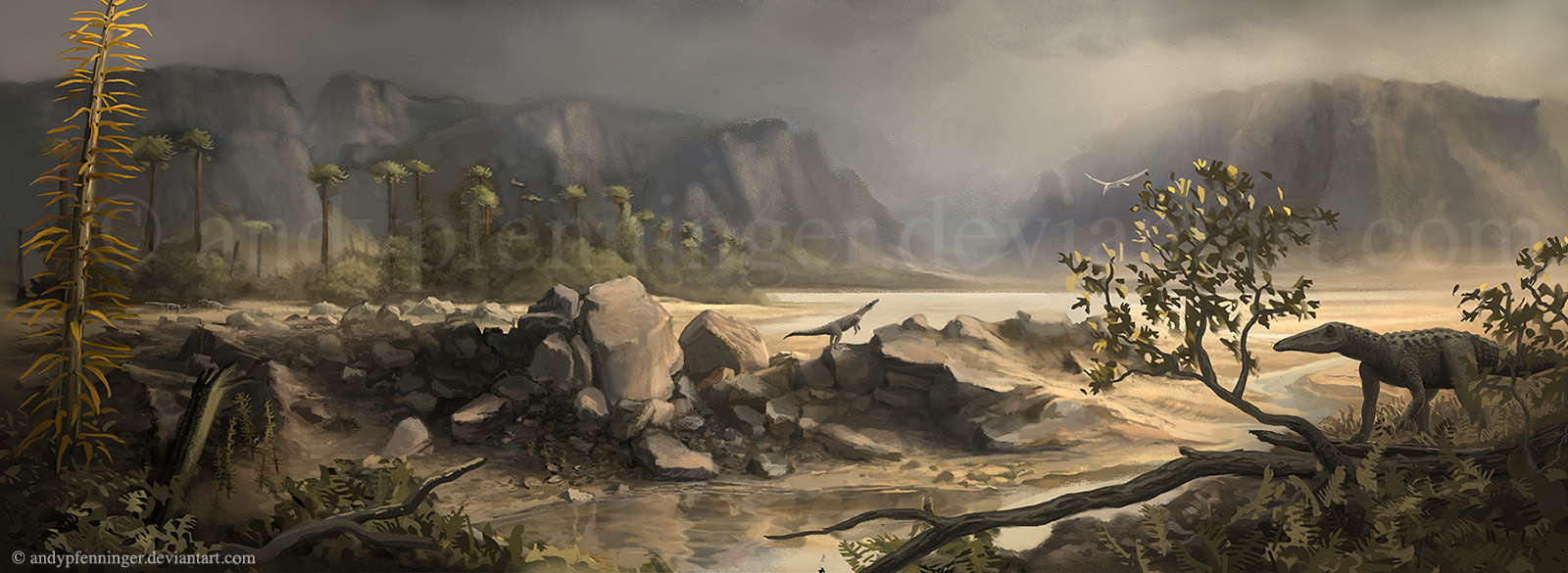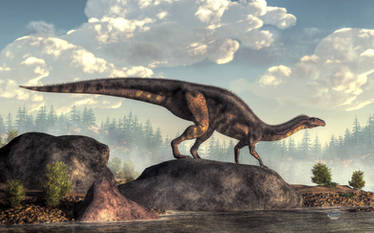Deviation Actions
Description
I would like to get some critique from paleo- enthusiasts and illustrators. For those who are interested in the thoughts behind this illustration and the context in which it was made, please read the following:
General Infos about the animal:
This is a raw attempt to illustrate Carnufex Carolinensis, an early ancestor of modern crocodiles which lived during the late triassic period about 232 million years ago in North America. This three meter long Crocodylomorph is thought to have been the top- predator of its ecosystem until the dinosaurs went on to fill these role. In comparison to modern crocodiles, Carnufex Carolinensis is thought to have been more of a terrestrial animal (land- living) and walked on its hind legs which were much longer than those of modern crocodiles.
This interesting predator was first described in 2015 by Lindsey Zanno (Zanno Lab: zannolab.wordpress.com) and was found in the carnian- age pekin formation in Chatham County, North Carolina.Context:
This illustration was thought as an exercise within my Scientific Illustration- study in Luzern Switzerland. Within about five weeks every student should realize his individual project, including the brainstorming, scientific research, conceptualization, execution, meetings with the teachers, revision and final presentation. The main topic for this exercise was RAINFOREST. But I wanted really badly to do some paleoart
Weather/ Climate:
The Triassic climate was generally hot and dry.
But at the time Carnufex Carolinensis lived, North Carolina was a wet, warm equatorial region beginning to break apart from the supercontinent Pangea.
And thats what I wanted to best represent in my illustration. I wanted to show a change from a long hot and dry season to an upcoming rainy season which is announced by thunderclouds in the upper left corner of the illustration. There is a lot of moisture in the air which gets heated up by the sun on the right and creates kind of a misty greenhouse and gives the illustration a dramatic atmosphere.
Flora:
In the foreground you can see some triassic flora including Pleuromeia, Glossopteris and ferns. And in the background little forests with some Auracaria- trees. As far as I could find out during my relatively short research- time, it seems like there is not a lot of fossile records on the triassic flora in this region. So I don't really know if this plants were typical for this region during the triassic period, but I assume they were typical for the late triassic period in general and therefore widely spread over the supercontinent Pangea.
Landscape:
Because of the general climate during the triassic period, the typical deposits of that time are red sandstones. This fact inspired the colors for the landscape.
This very warm tones gave me a nice contrast to the more cold tones of the sky and the background.
To represent the triassic rift basins around North Carolina, I wanted to bring in some steep dry canyons. I had the idea of Pangea braking apart and leaving this deep canyons and basins which got filled with sea- water. I also had the idea of this basins drying out during the dry seasons and leaving salty beaches which more or less can be seen on the right background.
Carnufex Carolinensis:
There is, as far as I know, only one officially used illustration of this animal by Jorge Gonzales. Thats why I was so interested in illustrating it.
I wanted to illustrate something new that wasn't done often before. Gonzales illustration shows this animal separated from its habitat, very realistically and detailed. My approach was to show this animal in its habitat, but not as detailed as Gonzales did. We really don't know how exactly this animals looked like, how their skin was colored and how they behaved. So I set my Carnufexes into a slight backlight- situation to define their shape without having to give them to much detail, without having to make to much unqualified statements. I gave them just the texture and color they needed to be readable as extinct Crocodylomorphs. In total there are four animals in this illustration. Two of them stand on their hind legs, two on all four. I wanted to show, that Carnufexes maybe used all four to climb around and sometimes walked only on their hind legs to hunt, fight or just overlook the environment. I also wanted to show one taking a bath in the foreground- basin as a reference to our modern semi- aquatic crocodiles. But I gave up this idea, because I didn't want to overload the illustration with too many animals around the same spot. Concerning reference material, I've consulted pictures of modern crocodiles and of course the official material by Zanno Lab.
Critiques:
I hope my english wasn't too bad. I would love to read what you think about this illustration. As mentioned in the beginning, critiques for every aspect of this illustration are highly welcome! I hope everything I've wrote was correct from a paleontological standpoint of view. Please correct me if there's something wrong.
Thank you very much for reading my explanations, giving comments and helping me to improve my skills and knowledge!
.
.
.
.
.
I've never given a critique before, but I think this is a good chance to give it a try.
For vision it's quite easy to see what you tried to depict. That you also wrote about it in your description makes it easy to understand for those who don't really know what paleoart is, for example: this could also be a fantasy landscape or something like that.
The whole summary of what's in the picture and how you came to this final result is also a good extra. It's always interesting to get a look at the proces the artist went through.
Four stars for originality because the Triassic period doesn't get much attention, I think. Most of the time it's Jurassic or Cretaceous life and sceneries that get depicted. Another positive thing is the incoming rain: Mesozoic scenes end up with tropical, sunny environments in most works even though that definitely wasn't always the case. It's good to see some forces of nature at work.
And let's not forget the subject: the Carolina Butcher. Crocodylomorphs don't get a lot of attention either, so it's nice to see you chose to work with this animal.
I can't really say much about technique because I barely have any experience with photoshop, but looking at this I'm sure you know how it works. Didn't give you the full four stars because it's not super-duper-detailed. I'm not saying that's bad of course, not at all!
Almost giving you the maximum for impact because I really enjoyed looking at this piece, trying to give everything a view. There's a lot hidden in the landscape. The latter looks very realistic, definitely gives the watcher a look back in time of a forgotten land.
And that's it. I hope your teachers are going to give you good comments about this. You definitely deserve that with this artwork.


































